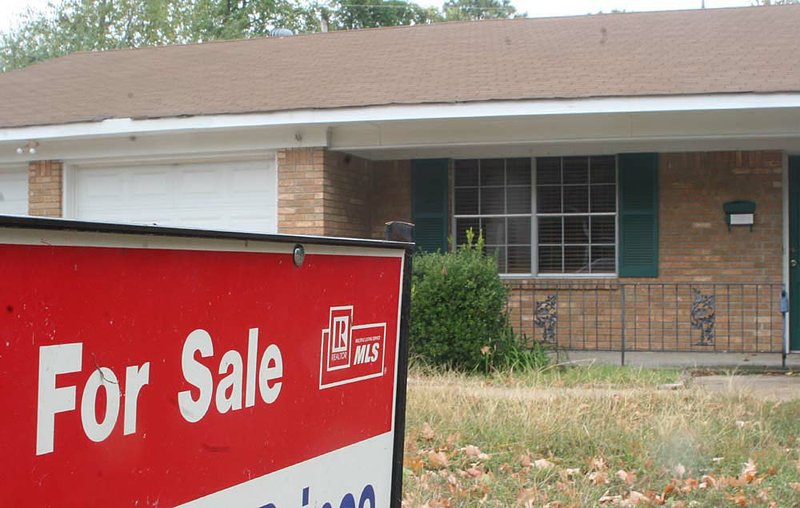LITTLE ROCK — Sales of U.S. existing homes rose in September by the most on record, a sign cheaper borrowing costs are helping stabilize an industry that’s battling the head winds of foreclosures and joblessness.
Purchases increased 10 percent to a 4.53 million annual rate from 4.12 million in August, the National Association of Realtors said Monday in Washington. Economists had forecast sales would rise to a 4.3 million pace, according to the median projection in a Bloomberg News survey.
Despite the big September uptick, existing-home sales were down 19 percent compared with September 2009, before adjusting for seasonal patterns.
The median sale price in September fell 2.4 percent from a year earlier.
In Arkansas, poor consumer confidence caused home sales to drop almost 15 percent in August, the most recent information available, according to the Arkansas Realtors Association. Unlike the national figures released Monday, the Arkansas report includes both previously owned and newly built homes.
Nationally, the lowest mortgage rates on record and cheaper homes are enticing some buyers and providing a backstop for the industry that precipitated the worst recession since the 1930s. At the same time, the housing recovery will be slowed by unemployment forecast to exceed 9 percent through 2011 and foreclosures that add to the inventory of unsold homes.
“Even with this improvement, you’re still at a remarkably depressed level,” said Tom Porcelli, senior economist at RBC Capital Markets Corp. in New York. “We’re going to continue to muddle along here, given the supply demand imbalance.”
Estimates of the 72 economists surveyed by Bloomberg for September sales ranged from 4 million to 4.8 million. In July, sales ran at a 3.84 million annual rate, the weakest in a decade’s worth of re-cord-keeping by the Realtors group.
Still, stocks rose Monday as investors bet the Federal Reserve will announce further action to stimulate the economy after it meets next week. The Dow Jones Industrial Average rose 31.49 points, or 0.3 percent, to 11,164.05. Treasury securities were little changed.
Monday’s report showed that existing-home sales last month rose in all four regions, led by a 14.5 percent jump in the Midwest.
The median price decreased 2.4 percent to $171,700 last month from September 2009.
Purchases of single-family homes rose 10 percent to a 3.97 million annual rate in September from a month earlier, the realtors association said.
The number of previously owned homes on the market fell 1.9 percent to 4.04 million. At the current sales pace, it would take 10.7 months to sell those houses, compared with 12 months in August.
Distressed sales, which include foreclosures and short-sales in which the bank agrees to take less than the full amount of the mortgage, accounted for 35 percent of total sales.
A government tax credit of as much as $8,000 gave housing a temporary lift late last year and into 2010. Purchases plunged in July, the month after buyers were originally required to close deals in order to get the incentive. Sales of existing houses are lower than the 4.83 million average pace set during recession that ended in June 2009, and are well off the record 7.25 million peak reached in September 2005.
Foreclosure moratoria at JPMorgan Chase & Co. and other banks, along with government investigations into faulty paperwork, threaten to further delay a recovery as houses slated for repossession take longer to come to market.
“You’re going to see uncertainty on the part of homebuyers,” said Quinn Eddins, director of research at Radar Logic Inc., which tracks the housing market.
Foreclosures are mounting as out-of-work Americans can’t meet monthly payments while growing numbers of homeowners, seeing their home prices slide to less than their mortgage values, also default.
The U.S. central bank and other regulators are “intensively” examining financial firms’ home-foreclosure practices and expect preliminary findings next month, Federal reserve Chairman Ben Bernanke said Monday.
“More than 20 percent of borrowers owe more than their home is worth, and an additional 33 percent have equity cushions of 10 percent or less, putting them at risk should house prices decline much further,” Bernanke said.
Housing markets were “weak,” with “sluggish or declining” sales in many regions, the Fed said last week in its survey of regional districts for September and early October. “Respondents’ outlooks suggested sales and construction would remain subdued through year-end,” restrained in part by lending standards and “general economic uncertainty,” the Fed said.
Housing starts in September were 73 percent below the three-decade peak of 2.27 million reached in January 2006.
Information for this article was provided by David Smith of the Arkansas Democrat-Gazette and Alan Zibel of The Associated Press.
Front Section, Pages 1 on 10/26/2010

